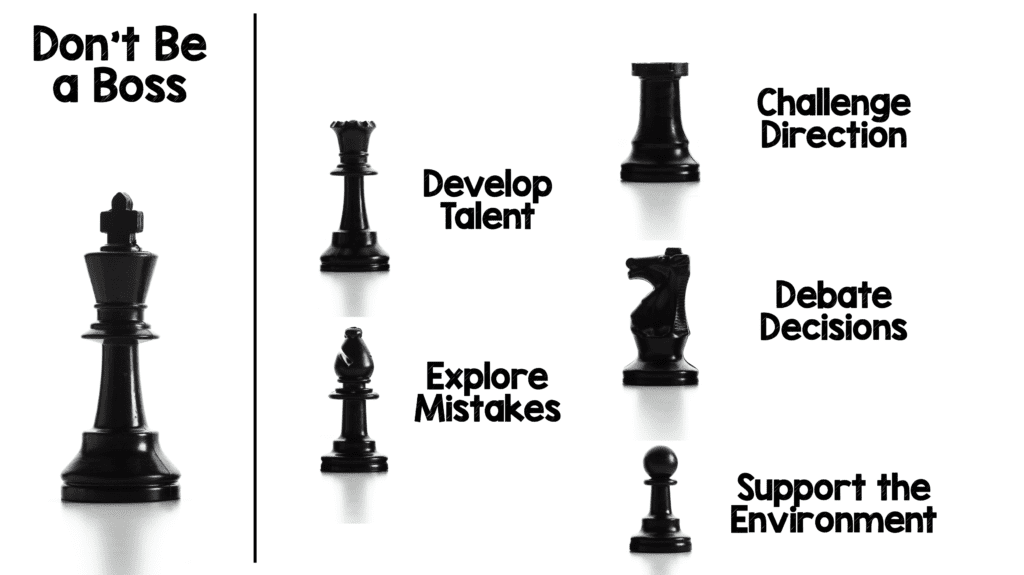
 When I was a kid, I used to play chess with my grandfather every day. Each piece on the chess board had unique moves that could be made in order to help win and capture the other person’s king (i.e. checkmate). I used to think the king was the most important piece when I was kid, but the truth is, the king, had some of the most limited moves. A more reasonable reality is that the strength of the king is enhanced by optimally orchestrating and enhancing each of the other piece’s abilities. A team can either be successful or fail based on the management style of a leader.
When I was a kid, I used to play chess with my grandfather every day. Each piece on the chess board had unique moves that could be made in order to help win and capture the other person’s king (i.e. checkmate). I used to think the king was the most important piece when I was kid, but the truth is, the king, had some of the most limited moves. A more reasonable reality is that the strength of the king is enhanced by optimally orchestrating and enhancing each of the other piece’s abilities. A team can either be successful or fail based on the management style of a leader.
Recently, I also read a book called Multipliers, by Liz Wiseman who does an absolutely amazing job talking about the attributes of successful leaders. I began to think about the ideas in this book and the analogies that could be made to the pieces on a chess board. From this combination, I developed a talk on leadership : “Titles Don’t Make Leaders.”
Titles Don’t Make Leaders
[embedyt] http://www.youtube.com/watch?v=k3g8oSKEq1k[/embedyt]
Checkout More REBEL EM Videos on our YouTube Channel
Don’t Be a Boss (King)
“People ask the difference between a leader and a boss. The leader leads, and the boss drives.” Theodore Roosevelt
What actions can make you a boss?
- Being a Rescuer: At the first sign of distress, you jump in and help. This is the most common way leaders accidentally diminish their team. By reacting every time there is an issue, you deprive people of the feedback that comes from the natural consequences of failure/mistakes
- Being an Empire Builder: Acquire resources, but underutilize their talent (i.e. owners of talent, but not developers of talent)
- Being a Rapid Responder: These leaders are quick to respond, trouble shoot problems and make fast micro-decisions. By reacting quickly, the people around you tend to react slowly if at all.
Bottom Line: Sometimes, the best intentions of a leader, can be the most diminishing to those around them
Develop Talent (Be Nurturing Like a Queen)
“Outstanding leaders go out of their way to boost the self-esteem of their personnel. If people believe in themselves, it’s amazing what they can accomplish.” Sam Walton
- Find peoples native genius and label it: Native genius is something that people do, not only exceptionally well, but absolutely naturally.They do it easily without extra effort) and freely (without condition). By telling people what you see, you can raise their awareness and confidence, allowing them to provide their talent more fully
- Supersize challenges: By giving challenges that are one or two sizes too big, you push people’s boundaries by getting them out of their comfort zone. By pushing people’s boundaries of comfort, we push them to grow and fully utilize their minds. Connecting people’s natural passions to bigger opportunities, you allow those people to be used at their highest point of contribution.
- Don’t be a superstar: I know this sounds counterintuitive, but a better place to be is to assist superstars. By being a superstar, you impede the growth of others. (Just think about Michael Jordan playing basketball vs Magic Johnson playing basketball àWho helped make everyone around them better?)
- People often worry that by developing talent and giving them bigger opportunities, they will run out of talent as their superstars move on.The reality is, by developing talent, you get a reputation as a place to grow, which recruits new talent and thus creates an endless cycle of new talent.
Bottom Line: Don’t own talent, develop it
Explore Mistakes (Bishop)
“I think it’s very important to have a feedback loop, where you’re constantly thinking about what you’ve done and how you could be doing it better. I think that’s the single best piece of advice: constantly think about how you could be doing things better and questioning yourself.” Elon Musk
- Listen more than you talk: learn what other people know and add it to your own reservoir of knowledge.
- Level the playing field (Get rid of hierarchy): formal hierarchies suppress the voices, and often ideas of those at the bottom.Amplify voices to extract maximum intelligence and give advantage to ideas and voices on the lower end of the playing field. Wisdom doesn’t just come from the top, it comes from all across any organization
- Learn from mistakes: this is an essential part of progress. Give people space to make mistakes by creating an environment of learning
Bottom Line: Don’t dominate the space by over-expressing your ideas and being critical of others, let others express their ideas
Challenge Direction (Castle)
“The challenge of leadership is to be strong, but not rude; be kind, but not weak; be bold, but not bully; be thoughtful, but not lazy; be humble, but not timid; be proud, but not arrogant; have humor, but without folly.” Jim Rohn
- Ask big questions and let others find the answer (i.e. mission impossible): By acknowledging the impossible nature of a mission, you give people permission to try without fear of failure (Provide a framework, and challenge others to fill in the blanks).
- Go for small early wins (law of marginal gains): Break the challenge into reasonable increments so the team can build intellectual muscle and the confidence that comes from clearing progressively higher bars.People get smarter and stronger by being challenged. This creates belief that the impossible is possible.
- Reframe problems into opportunities: the most powerful work is done in response to an opportunity not in response to a problem.
- We often think burnout is a result of working too hard; more often burnout occurs when people are merely doing more of the same or when they can’t see the results of their hard work.
Bottom Line: Don’t give direction that showcases your knowledge, allow people to stretch toward future opportunities
Debate Decisions (Knight)
“Coming together is a beginning; keeping together is progress; working together is success.” – Henry Ford (1863 – 1947), American Industrialist and Founder of the Ford Motor Company
- Have everyone participate: Through dissection, dissent, and debate from the entire team can sound decisions be made. This also helps develop collective intelligence.
- Have people change/switch positions: If someone is arguing strongly for a particular point, have them switch positions and think about the negative connotations associated with that decision as well.
- Fact-based not opinion-based arguments: viewpoints should be based on evidence. Anytime someone wants to contradict an opinion, it is important to first restate the views of the other person and have those confirmed, to ensure both parties are understanding each other correctly before contradicting that view.
- Viewpoints should be based on evidence. Anytime someone wants to contradict an opinion, it is important to first restate the views of the other person and have those confirmed, to ensure both parties are understanding each other correctly before contradicting that view.
Bottom Line: Don’t make quick decisions, based solely on your own opinion, but get the input of others
Support the Environment (Pawn)
“Leadership is about making others better as a result of your presence and making sure that impact lasts in your absence.” Sheryl Sandberg
- Give ownership: When people are given ownership for the whole of a project, they stretch their thinking and challenge themselves to go beyond their scope. By asking people to stretch and do something they’ve never done before, we stretch the person in it. Therefore, don’t just have people identify problems, but also have them identify a solution. When we ask for a solution, we give people an opportunity to complete their own thinking and work.
- Create a safety net: feedback as guidance rather than an order. Someone who is working on something full-time, for many weeks, has insights into that thing that you as a leader won’t have after a few minutes. When leaders teach, they invest in people’s ability to solve and avoid problems in the future. By doing this, we generate independence in others. This investment in others allows others to apply their full intelligence to the work at hand, and also to expand their scope and influence. As a side effect, this ensures sustained performance without the direct involvement of the leader in every aspect.
- Offer help, but have an exit plan: When you see a team member struggling, offer help, but have an exit plan to let them continue to lead.Be available to help someone learn from failures, but don’t just jump in and fix an assignment just so it won’t fail. Nature teaches best. When we let nature take its course and allow people to experience the natural consequences of their actions, they learn most rapidly and most profoundly. Real intelligence gets developed through experimentation and by trial and error.
Bottom Line: Don’t micromanage, but allow others to take on ownership
How to be A Leader

“If your actions inspire others to dream more, learn more, do more, and become more, you are a leader.” John Quincy Adams
- Don’t be a Boss –> King
- Develop Talent –> Queen
- Explore Mistakes –> Bishop
- Challenge Direction –>Castle
- Debate Decisions –>Knight
- Support the Environment –>Pawn
Post Peer Reviewed By: Anand Swaminathan, MD (Twitter: @EMSwami) and Mizuho Morrison, DO (Twitter: @mizspangler)
The post Titles Don’t Make Leaders appeared first on REBEL EM - Emergency Medicine Blog.
